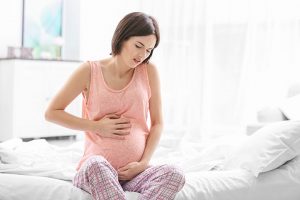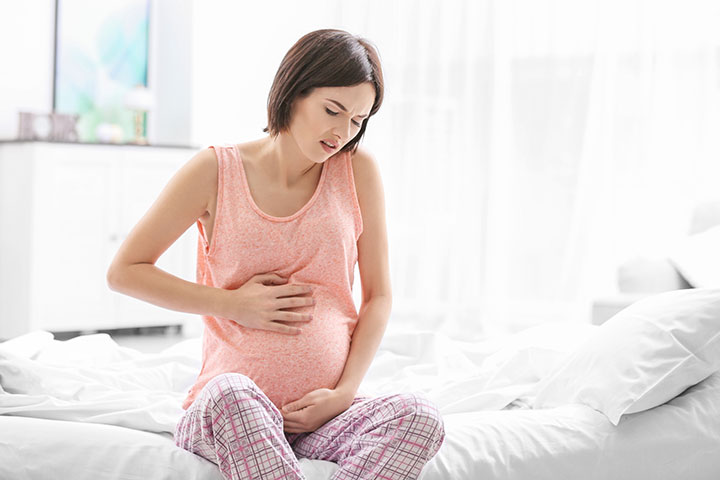TS is a 29-year-old pregnant female at 31 weeks’ gestation with a singleton fetus who presents in the labor and delivery department with lower right abdominal pain. She describes the pain as sharp, continuous, and radiating from her abdomen to her back and down her legs. TS reports a pain score of 5 out of 10. A liter of lactated ringers is started intravenously to run at 125 cc an hour, and an external fetal monitor is applied. TS is visibly upset and expresses anxiety about losing the pregnancy after suffering two prior miscarriages.
Health history
TS further describes her abdominal pain as starting 3 hours earlier with no increase in intensity over time. Nausea began shortly before the pain started, and she has had one episode of emesis with a small amount of yellow vomitus. She has not had any diarrhea and no chills or fever. She has not taken any medications for her pain or nausea. On further questioning, TS reports no vaginal bleeding, vaginal discharge, leaking of amniotic fluid, or burning/urgency/bleeding on voiding. She has not had any physical injury nor is she aware of any recent activity that would cause abdominal muscle pain. She is feeling regular fetal movement and no contractions.

TS is G4P1021. A review of her obstetric history reveals that she had two miscarriages after one live birth 4 years ago. TS and her husband are happy about the pregnancy. She denies any depression and is only anxious now because of the pain and concerns about the baby’s well-being. TS has no history of gastrointestinal, gynecologic, or urologic conditions, no surgeries, and no known medication or food allergies.
This pregnancy has been without complications. TS has had regular prenatal care with the most recent office visit 10 days ago. Initial prenatal lab records indicate negative chlamydia and gonorrhea tests. A routine ultrasound at 20 weeks was normal confirming a singleton pregnancy and expected gestational age. TS reports that she has gained 20 lbs. thus far in the pregnancy. She has had occasional constipation, but additional fiber and fluid intake has helped. She reports no problem with heartburn during this pregnancy. She takes only prenatal vitamins and denies alcohol or any other medication intake.
Physical examination and laboratory tests
The admission vital signs of TS are stable: 98.2° F, blood pressure 124/86 mm Hg, respirations 18 breaths per minute, pulse 84 beats per minute, and oxygen saturation of 98% on room air. Her skin is warm, dry, and without lesions, erythema, or jaundice. Lung sounds are clear. Abdominal examination reveals a gravid abdomen, the uterus is firm with no rigidity, and fundal height is 30 cm. Bowel sounds are present. There are no abdominal bruits or friction rubs. The patient exhibits guarding with negative McBurney’s sign, moderate right lower quadrant rebound tenderness, and no referred pain. Murphy’s sign is negative. There is no costovertebral tenderness or tenderness or enlargement of the liver or spleen.
External fetal monitoring shows a baseline fetal heart rate at 140 to 150 beats per minute, moderate beat-to-beat variability, accelerations with fetal movement, and no decelerations. There are no contractions present, and uterine activity shows normal tone fluctuations. A vaginal speculum exam reveals no abnormal discharge, bleeding, or lesions. Fern testing of vaginal secretions is negative for amniotic fluid. There is no cervical dilation or effacement. Specimens for chlamydia and gonorrhea tests and group B strep are obtained. Results for these tests are negative.
Differential diagnosis
To arrive at a diagnosis, all factors must be considered including analyzing history, physical examination, and laboratory findings to treat the patient, not just the data. For TS, both obstetric and nonobstetric diagnoses must be considered. After the initial history was obtained, physical exam performed, and laboratory tests analyzed, several differential diagnoses were ruled out. These diagnoses included upper abdominal conditions such as cholecystitis, pancreatitis, rupture of the liver, and splenic artery aneurysm rupture. Other diagnoses such as gastric disorders including constipation, intestinal blockage, gastric ulcer, inflammatory bowel disease, and strained abdominal muscle were also ruled out. The absence of uterine contractions on external fetal monitoring, no cervical dilation or effacement, and a negative fern test for amniotic fluid eliminated preterm labor and premature rupture of membranes. Physical exam findings, fetal well-being assessment, normal hemoglobin and hematocrit values, and normal platelet, PT/PTT [prothrombin time/partial thromboplastin time], and fibrinogen levels are reassuring that there is no placental abruption, uterine rupture, or uterine torsion. Laboratory findings also did not indicate presence of kidney stones, pyelonephritis, urinary tract infection, or cervical infection. Further investigation is needed to confirm no fetal, uterine, or placental abnormalities and to determine the source of the abdominal pain and WBC elevation.
Diagnostic imaging studies
The choice of diagnostic imaging studies requires special attention when caring for the pregnant patient with acute abdominal pain. Ultrasonography is the first line of diagnostic testing, but as the uterus enlarges in the second and third trimesters the ability to clearly view all abdominal organs can be impaired. The second line of diagnostic testing is use of computed tomography scan, although there is a theoretical risk of radiation exposure to the developing fetus. The American College of Radiology recommends magnetic resonance imaging (MRI) as it provides quality imaging of soft tissue without the risk of fetal radiation exposure.1
TS has both a transvaginal ultrasound and transabdominal ultrasound performed. Cervical shortening is not visualized, and a viable, estimated 31-week gestation female fetus with positive fetal movements and tone is seen. The placenta is implanted at the fundus of the uterus with no anomalies noted. An abdominal sonogram of left and right kidneys, bladder, and appendix is performed next. Due to the gravid state, the appendix is not visible on ultrasound, so MRI without contrast is performed with results equivocal, showing slight irritation to the walls of the appendix with no fluid noted. MRI has been shown to be highly accurate at diagnosing acute appendicitis in pregnant women, with a sensitivity and specificity between 92% and 98%.2–5
Acute appendicitis
Appendicitis is the most common nonobstetric surgical emergency that occurs during pregnancy.6 Statistics related to the occurrence of appendicitis vary between 1 in 500 to 1 in 2,000 pregnancies.7,8 Appendicitis can occur throughout all trimesters of pregnancy, although it is most often diagnosed in the second trimester.1 Diagnosing acute appendicitis during the third trimester of pregnancy may be difficult because of the displacement of internal organs and structures due to the gravid uterus.9 Additionally, abdominal stretching in late gestation can result in a diminished pain receptor response so guarding and rebound tenderness may be lessened.1,10,11 The usual presentation of fever, periumbilical pain, right lower quadrant pain, irritation of the peritoneum, rebound and McBurney’s point tenderness may deviate when the patient is in the advanced pregnant state.

Desired outcomes
Quick and concise diagnosis and treatment are needed when confronted with acute appendicitis in the pregnant patient. Failure to accurately treat can result in a perforated appendix and unfavorable outcomes for both mother and fetus such as sepsis, preterm birth, and intrauterine demise. The desired outcomes are twofold. One is prevention of complications of appendicitis. The other is prevention of treatment-related harm to mother and fetus.
After diagnosis of acute appendicitis has been established, treatment decisions are based on stability of the mother and fetus, severity and persistence of pain, and any other significant physical exam and lab test findings. The definitive treatment is typically surgery. In lieu of surgery, medical management with antibiotic therapy and intensive patient monitoring has been shown to be an effective treatment for uncomplicated appendicitis and without maternal and/or fetal problems.12,13 The avoidance of surgery assists with decreased length of hospital stay, decreased hospitalization costs, and elimination of risk for surgical and postsurgical complications.13
Plan and implementation of care
Based on the findings and probable diagnosis of acute appendicitis, TS is referred for a surgical consult. The surgical and radiology team review MRI results and determine a plan to continue IV fluids with an overnight hospital stay for observation. Antibiotic treatment is deemed unnecessary. The next morning, blood samples are drawn again in which WBCs decreased to 8,000. Vital signs remain stable, and TS had no increased temperature throughout the night. She reports markedly diminished abdominal pain and denies nausea. The surgical team and obstetrician review the case and, pending tolerance of food and fluids, allow discharge from the hospital. Discharge teaching for TS includes monitoring symptoms and instruction to return to the labor and delivery department if pain reappears, fever occurs, food and fluids are not tolerated, vaginal leakage or bleeding is experienced, there is a decrease in fetal movement, or if contractions are noted. TS has an appointment with her obstetrician in 3 days.
Generally, the plan of care for acute appendicitis is surgical removal. However, risks of surgical and postsurgical complications must always be considered.5,14 Technologic advances in diagnostic imaging help in accurately diagnosing appendicitis early enough to allow for alternatives in treatment that may include antibiotics or supportive care without surgical and/or medical interventions.5,12 Acute appendicitis has been shown to successfully resolve without using antibiotic therapy, although this course of action should be implemented based on the clinical case.5,15 Patients identified as candidates for nonsurgical and nonmedical interventions should be evaluated and monitored carefully so that complications and re-hospitalizations after discharge are avoided. It should be noted that pregnant patients diagnosed with acute appendicitis and treated conservatively do run the risk of possible recurrence of the condition.5
Implications for nurse practitioners
Nurse practitioners who provide prenatal care must be able to recognize emerging complications during pregnancy in a timely manner. Delaying diagnosis could result in risk to the mother’s health and risk to fetal well-being, normal growth, and development. The astute NP will recognize that when a pregnant patient presents with acute abdominal pain, both obstetric and nonobstetric conditions must be considered. Careful history taking, physical examination, and appropriate laboratory tests and diagnostic imaging guide the direction of treatment. Diagnosis of appendicitis in the third trimester may be more difficult for several reasons, including potential confusion with normal gastrointestinal discomforts of pregnancy, displacement of abdominal organs by the enlarging uterus, and an interpretation of increased WBCs as part of normal leukocytosis of pregnancy.16
Get more news like this for Nurse Practitioners delivered to your inbox biweekly. Sign up here.
A team approach with obstetric, radiology, and surgical evaluations will determine the best treatment for appendicitis during pregnancy. Conservative measures to manage acute appendicitis without surgery can be an acceptable choice for pregnant women meeting appropriate criteria.17 As was the case of TS, careful assessment of patient symptoms, analysis of laboratory findings, diagnostic imaging results, patience, and cautious ongoing observation allowed for conservative management of care for a pregnant patient presenting with acute appendicitis.
Of note, TS carried the pregnancy to term without further complications and gave birth to a healthy female infant at 39 weeks’ gestation. However, as with a small percentage of cases, there is a possibility of treatment failure with conservative treatment.18 Approximately 12 months after giving birth, TS faced similar symptoms as previously experienced and was admitted to the hospital for a laparoscopic appendectomy.
Danna L. Curcio is Assistant Professor in the Department of Nursing at College of Staten Island, CUNY, in Staten Island, New York. The author has no actual or potential conflicts of interest in relation to the contents of this article.
References
1. Zachariah SK, Fenn M, Jacob K, et al. Management of acute abdomen in pregnancy: current perspectives. Int J Womens Health. 2019;11:119-134.
2. Kave M, Parooie F, Salarzaei M. Pregnancy and appendicitis: a systematic review and meta-analysis on the clinical use of MRI in diagnosis of appendicitis in pregnant women. World J Emerg Surg. 2019;14(37):1-14.
3. Vidyasagar S, Abubacker Sulaiman F. The roleof magnetic resonance imaging to rule out suspected appendicitis in pregnant women. Int J Contemp Med Surg Radiol. 2018;3(1):65-69.
4. Meesa IR, Mammen L. MR imaging of pregnant women with abdominal pain and suspected appendicitis: diagnostic accuracy and outcomes. Int J Radiol Radiat Oncol. 2016.
5. Di Saverio S, Podda M, De Simone B, et al. Diagnosis and treatment of acute appendicitis: 2020 update of the WSES Jerusalem guidelines. World J Emerg Surg. 2020;15(1):27.
6. Aggenbach L, Zeeman GG, Cantineau AEP, et al. Impact of appendicitis during pregnancy: no delay in accurate diagnosis and treatment. Int J Surg. 2015;15:84-89.
7. Mohammed IF, AlBayati BA. Acute appendicitis in pregnancy: the presentation and the outcome. Eur J Molecul Clin Med. 2020;7(6):450-455.
8. Mangel R, Stead TG, Ganti L, Rosario J. Diagnosing appendicitis in pregnancy via ultrasonography. Cureus. 2019;11(9):e5562.
9. Holzer T, Pellegrinelli G, Morel P, Toso C. Appendectomy during the third trimester of pregnancy in a 27-year-old patient: case report of a “near miss” complication. Patient Saf Surg. 2011;5(1):11.
10. McGahan JP, Lamba R, Coakley FV. Imaging non-obstetrical causes of abdominal pain in the pregnant patient. Applied Radiol. 2010;39(11):10-25.
11. Sinclair JA, Marzalik P. Suspected appendicitis in the pregnant patient. J Obstet Gynecol Neonatal Nurs. 2009;38(6):723-729.
12. Talan DA, Saltzman DJ, DeUgarte DA, Moran GJ. Methods of conservative antibiotic treatment of acute uncomplicated appendicitis: a systematic review. J Trauma Acute Care Surg. 2018;86(4):722-736.
13. Joo JI, Park HC, Kim MJ, Lee BH. Outcomes of antibiotic therapy for uncomplicated appendicitis in pregnancy. Am J Med. 2017;130(12):1467-1469.
14. Salminen P, Paajanen H, Rautio T, et al. Antibiotic therapy vs appendectomy for treatment of uncomplicated acute appendicitis: the APPAC randomized clinical trial. JAMA. 2015;313(23):2340-2348.
15. Loftus TJ, Dessaigne CG, Croft CA, et al. A protocol for non-operative management of uncomplicated appendicitis. J Trauma Acute Care Surg. 2018;84(2):358-364.
16. Lotfipour S, Jason M, Liu VJ, et al. Latest considerations in diagnosis and treatment of appendicitis during pregnancy. Clin Pract Cases Emerg Med. 2018;2(2):112-115.
17. Nakashima M, Takeuchi M, Kawakami K. Clinical outcomes of acute appendicitis during pregnancy: conservative management and appendectomy. World J Surg. 2021;45(6):1717-1724.
18. Wojciechowicz KH, Hofkamp HJ, van Hulst RA. Conservative treatment of acute appendicitis: an overview. Int Marit Health. 2010;62(4):265-272.

